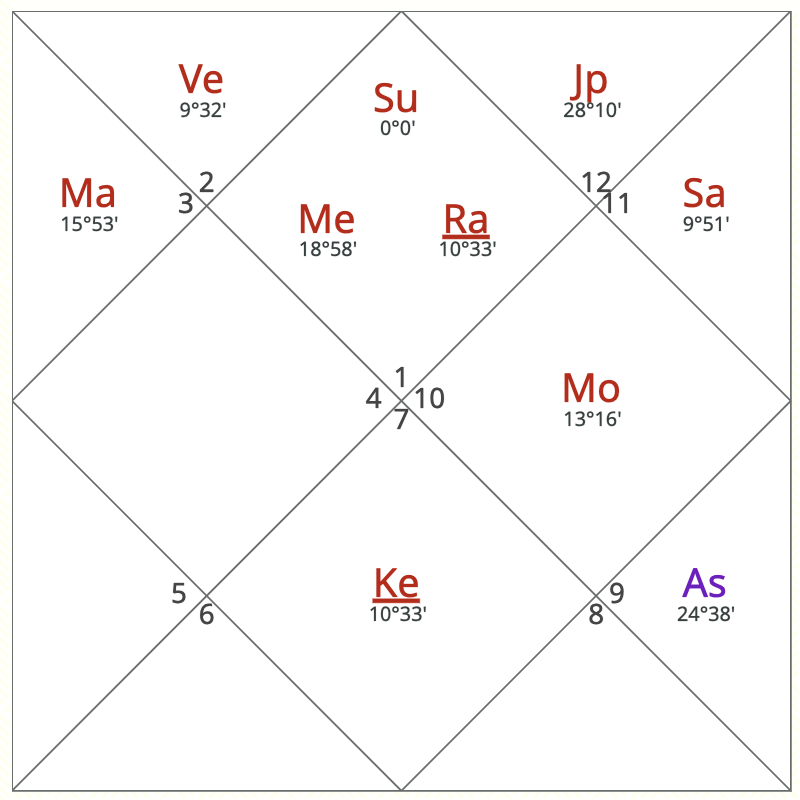Aries Saṅkrānti
Gocara Praveśa for Aries Saṅkrānti 2023
Today the sun moves into sidereal Aries marking the beginning of the sidereal new year. The sun is exalted in Aries because Aries is the natural 1st house of the zodiac connected to self-identity and the I-sense. In Sanskrit the word Saṅkrānti means to crossover or enter and refers to the Sun's entrance into a new sign. The sun is recognized as a form of divinity that provides light, heat, and resources for all living beings. The sun in Aries is worshipped as Dhātṛ Āditya, the form of the sun who provides leaders and leadership, knowledge, creativity, and the ability to change things.
What is Saṅkrānti?
The sun changes signs every 30 days so there are 12 Saṅkrāntis in a year. In fact, the movement of the sun through the tropical zodiac is what we call a year. The Sun at sidereal 29°44' - 0°16' in any sign is defined as sidereal Saṅkrānti. This is different than Saṅkrānti Doṣa where the Sun between 0°-1° in any sign is considered inauspicious in both Jātaka and Muhūrta charts.
Mundane results of Aries Saṅkrānti
The moment of Aries Saṅkrānti was early Friday morning at 2:14am in Nevada City, California. When the exact moment of Aries Saṅkrānti happens after midnight then we take the next day as Saṅkrānti, so religious celebrations and offerings are made on Friday. However, the mundane i.e., socio-political, results of the Sun's transit into Aries are predicted according to the exact moment of Saṅkrānti. This month Aries Saṅkrānti will keep the cost of goods and commodities normal because the Moon is in Śravaṇa, a Sama Nakṣatra. However, because Śravaṇa is also a Cara Nakṣatra this Saṅkrānti is named Mahodarī and will also benefit thieves and people who do dishonest work such as exploiting the wealth, resources, and labor of others. In California, Saṅkrānti occurred during the third watch (prahara) of the night - midnight to 3am - and so actors and dancers will face some challenges or set backs during this month.
Mundane results are also predicted according to the Karaṇa, half lunar day, of the moon at the time of Saṅkrānti. This month Aries Saṅkrānti takes place during Gara Karaṇa. According to Muhūrta Cintāmaṇi, sitting lifeforms (upaviṣṭa), adults, elephants and other domesticated animals, milk production, bows and hunting weapons, glass and mirror production, and red colored items will all see a loss during this month. According to Sage Vasiṣṭha, if rains fall on Aries Saṅkrānti then food will be plentiful (subhikṣa), and leaders, good men, and cows will prosper (nṛpasajjanagokulakṣema).
Transit predictions using Saṅkrānti
Did you know you can make monthly and yearly predictions based on the house the Sun transits from your ascendent and natal moon position? This chart shows the position of the nine planets at the exact time of Aries Saṅkrānti as seen from the Sun. The chart cast at the exact time of a transit is known as Gocara Praveśa. Check the exact moment of Aries Saṅkrānti for your location and note the position of the Sun from your rising and moon sign. The sun's transit is considered friendly in the 3rd, 6th, 10th, and 11th houses, but the placement of another planet other than Saturn in the 7th house from the Sun during its transit can block the auspicious results and make them less favorable. For example, the Sun's 3rd house transit supports gain of position (sthānaprāpti), collection of wealth (dhananicaya), sound health (kalyakṛt), and destruction of enemies (arihartā), so for Aquarius ascendents and Aquarius moons this is a favorable transit. However, if there is a planet transiting in Libra at the same time then the results will be reversed and behave more like the 9th house transit where danger (āpat), humiliation (dainya), illness (ruk), and obstruction to wealth and work (vittaceṣṭāvirodha) can be predicted.
Puṇya Kāla
The Puṇya Kāla, the auspicious time period of Aries Saṅkrānti, begins at sunrise and lasts for 16 ghaṭikās, about six and half hours, so from about 6:30am to 1:00pm in California. Sage Vasiṣṭha tells us that those who perform ancestral rites (śrāddha), offer food and water to the ancestors (tarpaṇa), bath in rivers and oceans (snāna), and/or donate to charity (dāna) during these times attain great fortune.


